Input Lag Solutions: Proven Methods for Lower Latency & Smooth Response
Updated On: November 13, 2025 by Aaron Connolly
Understanding Input Lag and Its Impact
Input lag happens when you press a button and have to wait a bit before that action shows up on your screen. Usually, people measure it in milliseconds.
Competitive players really feel these delays. Sometimes, a little input lag can be the difference between winning and losing.
Types of Input Lag
Display lag starts when your monitor processes the image before showing it. Gaming monitors usually keep this low, around 1-5ms, but old TVs can crank it up to 20-100ms.
System lag comes from how your PC or console handles your inputs. Your graphics card renders frames, your CPU does the game logic—sometimes they slow things down.
Network lag pops up in online games. Data needs to travel between your device and the game servers. Wired connections? They usually add 1-5ms. Wi-Fi? Expect 5-15ms, sometimes more if your signal’s spotty.
Peripheral lag is what you get from wireless mice, keyboards, or controllers. Depending on the device, wireless can add 1-10ms.
| Lag Type | Typical Range | Main Cause |
|---|---|---|
| Display | 1-100ms | Monitor processing |
| System | 5-50ms | Hardware performance |
| Network | 10-200ms | Internet connection |
| Peripheral | 1-10ms | Wireless delays |
All these add up to your total input lag. Most people start to notice lag above 30ms. Hardcore players want it under 20ms.
Why Input Lag Matters for Competitive Players
In esports, every millisecond counts. Sometimes, 10-20ms can decide the outcome of a match.
Take Counter-Strike 2 for example. Landing a headshot or missing can come down to just a few milliseconds.
Fighting games are even more sensitive. Some Street Fighter pros notice changes as tiny as 2-3ms, which is wild.
First-person shooters demand super accurate aim. If you’ve got high input lag, flick shots get tough, and tracking targets feels sluggish.
Tournament organizers often pick monitors with proven low input lag. The League of Legends World Championship? They use 1ms gaming monitors to keep things fair.
Pros sometimes travel with their own gear. They build muscle memory around specific lag timings, so even small changes can mess them up.
Common Myths About Input Lag
Myth: Higher refresh rates always reduce input lag. Not true. A 240Hz monitor with bad processing can lag more than a good 144Hz one. Response time matters more.
Myth: Gaming mode doesn’t make a real difference. Actually, gaming mode can drop input lag by 10-50ms by turning off image processing. That’s a big deal for competitive play.
Myth: Expensive gear eliminates all input lag. Even top setups still have 5-15ms of lag. You can’t get rid of it completely, but you can minimize it.
Myth: Input lag only affects professional players. Nope. Casual players feel it too, especially in games where reactions matter. Lower lag just makes everything feel snappier.
Myth: V-sync always increases input lag a ton. Modern adaptive sync like G-Sync and FreeSync barely add any lag compared to old-school V-sync, which could add 16-33ms.
Diagnosing Input Lag: Tools and Techniques
Finding where your input lag comes from takes a bit of detective work. You’ll need the right tools and a basic idea of how to read the numbers.
Let’s look at how you can test your system’s response times and spot your biggest performance bottlenecks.
Measuring Input Delay
You need good tools to figure out how long your inputs take to show up on screen. The best way is with a high-speed camera.
Camera Testing Method:
- Grab a camera that shoots at 240fps or higher.
- Film yourself pressing a key and watch the screen.
- Count the frames between pressing and seeing the action.
- Multiply by the frame time (4.17ms per frame at 240fps).
Software Testing Tools: If you don’t have a camera, try free programs like LatencyMon for Windows. Some games, like CS2, have built-in benchmarks.
Lots of gaming monitors now have input lag test modes. These show a timer that updates when you press a button, so you get instant feedback.
Quick Testing Tip: Online reaction time tests give you a rough baseline. Try a few runs and see your average.
Interpreting Latency and Ping Data
Understanding your measurements helps you figure out what’s actually causing problems. Different types of latency hit gaming in their own ways.
Input Lag Ranges:
- Under 20ms: Awesome for competitive play.
- 20-40ms: Fine for most games.
- 40-80ms: You’ll notice it in fast games.
- Over 80ms: Not great for gaming at all.
Network vs System Latency: Ping is all about network delay to the server. Input lag is your hardware’s delay. They both matter, but you fix them differently.
Reading the Data: Look for spikes, not just averages. Consistent 30ms feels better than bouncing between 10 and 50ms.
Jitter (those weird, inconsistent timings) often feels worse than a steady higher number. If your frame times jump around, you’ll probably see input lag spikes too.
Identifying System Bottlenecks
Once you get your numbers, it’s time to find out which part of your setup is slowing you down.
Different bottlenecks need different fixes.
Common Bottleneck Sources:
| Component | Typical Delay | Warning Signs |
|---|---|---|
| Monitor | 1-50ms | High input lag in all games |
| Graphics card | 5-30ms | Lag gets worse with higher settings |
| CPU | 2-20ms | Lag during busy scenes |
| RAM | 1-5ms | Stutters and lag spikes |
Testing Individual Components: Drop your graphics settings way down. If lag drops a lot, your GPU is struggling.
Close background programs one at a time. If things get better, your CPU was overloaded.
Display-Specific Issues: Turn on gaming mode on your monitor or TV. Watch out for features like motion smoothing—they can add delay.
Try different cables. HDMI and DisplayPort aren’t always equal, and some old HDMI versions can be slow.
Optimising System Performance
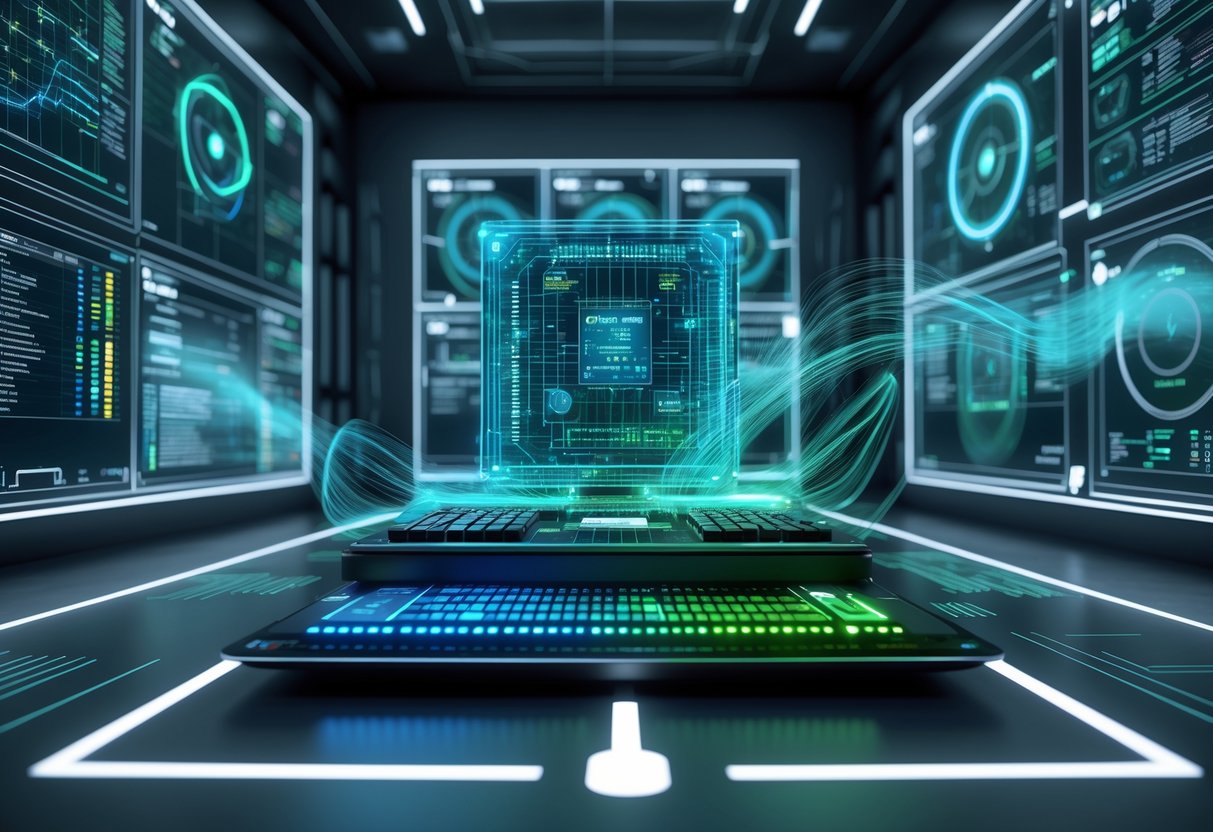
Your system’s performance shapes input lag by how quickly your computer handles game inputs and spits out frames.
If you manage what’s running, get the most out of your hardware, and keep your system tidy, you’ll cut down on input delay.
Managing Background Processes
Background apps can hog your CPU and slow down your game. Every extra program running steals a bit of performance, and it all adds up.
Open Task Manager with Ctrl + Shift + Esc and check the CPU column. If you see anything using more than 5% constantly, that’s a red flag.
Some usual suspects:
- Windows Update doing its thing
- Antivirus scans kicking off
- Browser tabs streaming stuff
- Cloud sync services uploading files
Windows Game Mode gives your game higher priority. You can turn it on in Settings > Gaming > Game Mode.
For more optimisation, disable programs you don’t need at startup. In Task Manager, go to the Startup tab and turn off things like Spotify, Skype, or Adobe updaters.
Pro tip: Close Discord’s hardware acceleration and any browser tabs before a big match. These tiny things can sneak in 2-5ms of input lag.
Maximising Hardware Efficiency
Your GPU and CPU need to work together. If either one lags behind, you’ll definitely feel it.
Graphics settings matter more than most people think. Lowering some effects can shave off 10-20ms of input lag, and you probably won’t even miss the visuals.
Settings to tweak:
- V-Sync: Turn it off for the lowest lag.
- Anti-aliasing: Drop it from 8x to 4x or less.
- Shadows: Medium is usually enough—Ultra just eats resources.
- Post-processing: Turn off motion blur and depth of field.
For your CPU, set your game’s priority to High in Task Manager. Right-click the game in the process list and pick “Set Priority > High”.
Close extra browser tabs and apps to free up RAM. Most games need 8-16GB of available RAM to avoid swapping to your slow hard drive.
Quick win: Use MSI Afterburner (or something similar) to watch your GPU and CPU usage. If you’re always hitting 90-100%, that’s probably your bottleneck.
Clearing System Cache
System cache fills up with temporary files. If you let it pile up, input processing can slow down and you’ll get random lag spikes.
Windows Disk Cleanup is easy to use. Just search for “Disk Cleanup” in the Start menu, pick your drive, tick the boxes (skip “Downloads”), and let it clear things out.
If you game in your browser or stream, clear your browser cache every month. Or just use private browsing so nothing builds up.
Game launchers like Steam or Epic Games also build up cache. In Steam, go to Settings > Downloads > Clear Download Cache.
For the registry, stick to Windows’ built-in tools. Run “sfc /scannow” in Command Prompt as admin to fix any corrupt files.
Skip third-party registry cleaners—they usually cause more trouble than they solve.
Set up automatic maintenance under Control Panel > System and Security > Security and Maintenance > Automatic Maintenance. This keeps things tidy without you having to remember.
Display Settings That Affect Input Lag
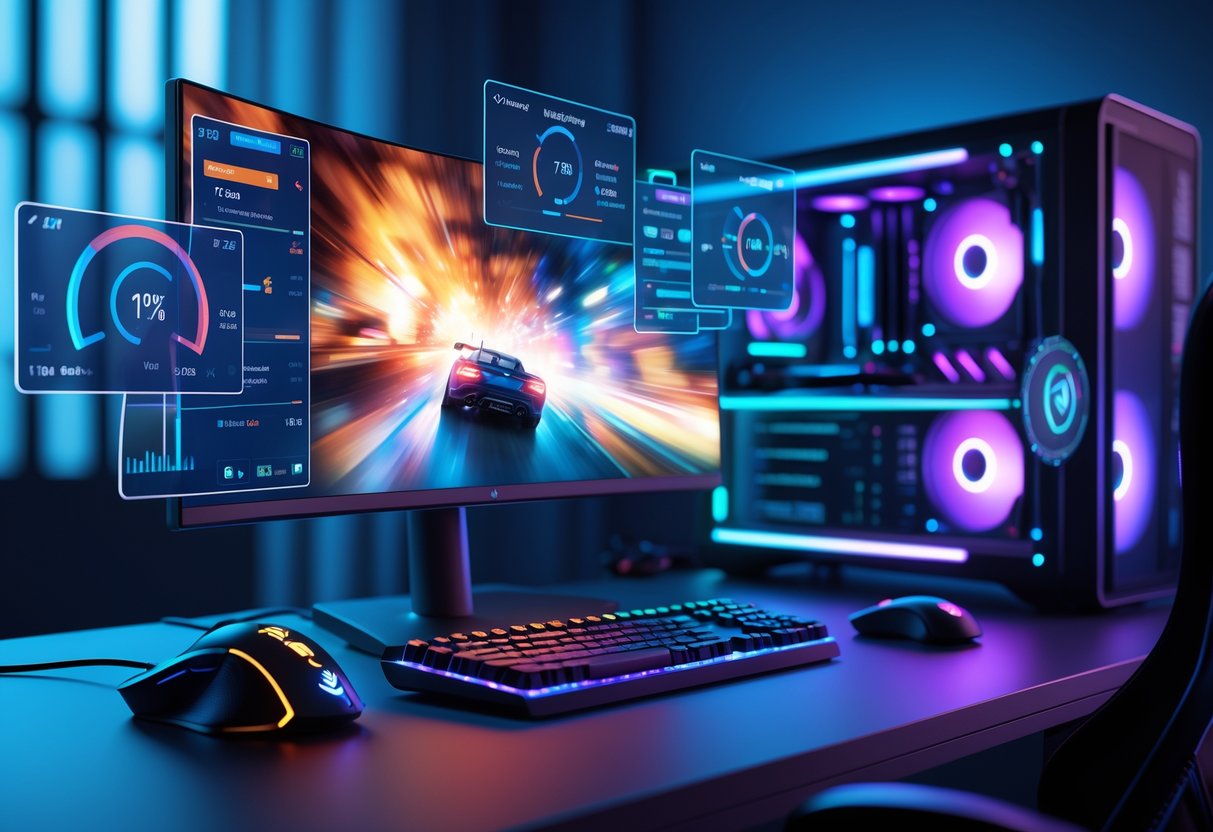
Your monitor’s display settings can absolutely make or break your experience. The big three? Refresh rate, response time, and display modes.
Each one changes how fast your actions show up on screen.
Choosing the Right Refresh Rate
Refresh rate tells you how many times your monitor updates the image every second. Higher numbers mean less input lag.
A standard 60Hz monitor refreshes 60 times per second. That’s 16.7ms between frames.
Gaming monitors step it up: 120Hz, 144Hz, 240Hz, even 360Hz.
A 144Hz monitor drops frame time to 6.9ms. That’s nearly 10ms faster than 60Hz.
High refresh rate monitors only help if your graphics card can keep up. If your PC barely manages 60fps, a 240Hz monitor won’t magically fix lag.
| Refresh Rate | Frame Time | Best For |
|---|---|---|
| 60Hz | 16.7ms | Casual gaming |
| 144Hz | 6.9ms | Competitive gaming |
| 240Hz | 4.2ms | Esports professionals |
Most people see a big difference moving from 60Hz to 144Hz. The jump to 240Hz is smaller, but if you’re serious about competition, it’s still worth it.
Understanding Response Time in Monitors
Response time tells you how quickly pixels shift from one colour to another. If you see a lower number, expect less motion blur and input lag.
TN panels hit 1ms response times, but their colour quality really leaves a lot to be desired.
IPS panels used to lag behind at 4-5ms, but honestly, the latest ones can now match that 1ms mark.
VA panels land somewhere in the middle with 2-4ms response times. They’ve got solid contrast, though their pixel switching isn’t the fastest.
Monitor makers sometimes exaggerate response times. Stick to “grey-to-grey” specs instead of falling for flashy marketing.
Overdrive settings can help lower response time, but they might bring in some weird overshoot artifacts. Try a few overdrive levels to see what feels best on your screen.
Configuring Display Modes for Gaming
Game Mode is crucial if you want to cut input lag. It turns off all those extra image processing features that slow things down.
Turn off these settings to get rid of lag:
- Motion smoothing
- Noise reduction
- Dynamic contrast
- Sharpening filters
- Colour enhancement
V-Sync stops screen tearing, but it adds a hefty chunk of input lag. For competitive play, keep it off. If you’ve got G-Sync or FreeSync, use those instead.
Display scaling adds extra processing. Stick to your monitor’s native resolution. Avoid upscaling whenever you can.
Switch your monitor to PC mode if you see that option. TV modes are for movies, and they just add more delay.
Many gaming monitors offer preset modes like “FPS” or “RTS.” These tweak several settings at once to help minimize input lag for different game genres.
Network Improvements for Lower Latency
Network problems can cause some of the worst input lag for gamers. You can solve most latency issues by improving ping, setting up stable connections, and fixing hardware hiccups.
Reducing Network Ping
Ping measures how long it takes for data to travel between your device and the game servers. Lower ping means less lag during matches.
Switch to a wired connection. Ethernet cables almost always give you a steadier connection than Wi-Fi. Wireless signals can drop packets and sneak in extra delay.
Try gaming VPN services made for low latency. Regular VPNs usually make ping worse, but gaming VPNs sometimes find faster routes.
Change your DNS settings to something quicker:
- Cloudflare: 1.1.1.1 and 1.1.1.2
- Google: 8.8.8.8 and 8.8.4.4
- OpenDNS: 208.67.222.222 and 208.67.220.220
Test different server regions in your game. Sometimes the nearest one isn’t actually the fastest.
Close bandwidth-heavy apps when you’re gaming. Streaming, downloads, and updates will absolutely spike your ping.
Setting Up a Stable Internet Connection
Stability matters more than raw speed for input lag. A reliable 50 Mbps line beats an unstable 200 Mbps one every time.
Router placement really matters. Put your router in a central spot, away from walls and metal. Elevate it on a shelf or desk if you can.
Update your router’s firmware often. Companies push out updates that fix bugs and improve performance.
Configure Quality of Service (QoS) settings:
- Prioritise gaming traffic over other devices
- Limit bandwidth for streaming and downloads
- Set your gaming PC or console as high priority
If you have to use Wi-Fi, go for the 5GHz band instead of 2.4GHz. 5GHz usually has less interference and works better for gaming.
If your download speeds are always under 25 Mbps, maybe it’s time to upgrade your internet package.
Troubleshooting Network Hardware
Old or dodgy network hardware can cause lag even if your internet is fast. A little maintenance keeps things running smoothly.
Replace network cables older than five years. Bad Ethernet cables can drop packets and cause disconnects. Go with Cat 6 or Cat 6a for best results.
Restart your modem and router once a month. Power cycling clears up memory issues and refreshes your connection.
Watch for overheating:
- Make sure your network gear has good airflow
- Clean dust out of router vents
- Swap out routers older than three years
Keep your network adapter drivers up to date. Sometimes Windows Update installs old drivers that hurt performance.
Run network diagnostics to spot problems. Use Windows’ built-in troubleshooter or tools like PingPlotter to hunt down issues.
If you’ve tried everything and still have problems, call your internet provider. They can check for line or signal issues on their end.
Advanced Operating System Tweaks
These tweaks dig deep into Windows to help cut input lag. They change how the system handles timing and processes, making gameplay feel more responsive.
Adjusting System Timer Resolution
Windows uses a default timer resolution of 15.6 ms. This delay can slow down how fast your key presses get processed.
Download TimerResolution from Microsoft Sysinternals. Open it and hit “Maximum” to set the lowest timer value.
This makes Windows check for input more often. Your mouse clicks and key presses should feel snappier.
Alternative Command Method
Open Command Prompt as admin. Type these commands:
bcdedit /set useplatformtick yesbcdedit /set disabledynamictick yesbcdedit /deletevalue useplatformclock
Restart afterwards. These tweaks make Windows handle timing with more precision.
Expected Results
Games and apps should feel more responsive. You’ll notice the biggest difference in fast-paced games where every millisecond counts.
Editing Registry Keys for Time Precision
The Windows Registry holds settings that affect system timing. Changing certain values can cut input lag.
Creating GlobalTimerResolutionRequests
Press Win + R and type regedit. Go to:
HKEY_LOCAL_MACHINESYSTEMCurrentControlSetControlSession Managerkernel
Right-click the right panel, pick “New > DWORD (32-bit) Value,” and name it GlobalTimerResolutionRequests.
Double-click it and set the value data to 1 (Hexadecimal).
Memory Management Registry Tweaks
Try these registry tweaks to help reduce lag:
| Registry Key | Value | Purpose |
|---|---|---|
| LargeSystemCache | 0 | Prevents memory delays |
| DisablePagingExecutive | 1 | Keeps critical files in RAM |
| Win32PrioritySeparation | 38 | Prioritises foreground applications |
Safety Precautions
Always back up your registry before making changes. These edits are permanent and affect core system behavior.
Restart to apply new registry settings. Your system should feel more responsive for gaming.
Peripheral Choices and Settings
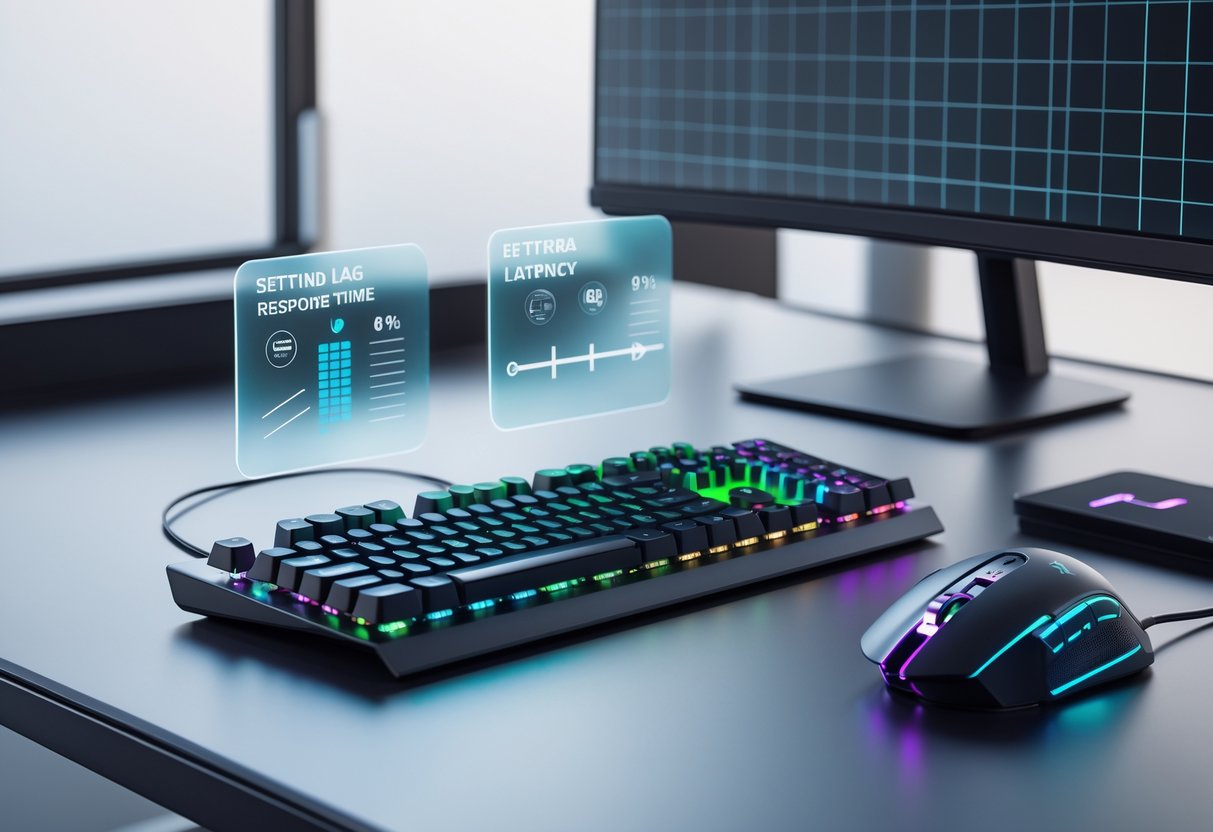
Your mouse, keyboard, and other gear play a huge role in how fast your actions reach the game. Picking the right hardware and keeping drivers fresh can shave off precious milliseconds.
Selecting Low-Latency Devices
Wired connections always beat wireless for serious gaming. USB cables cut out the tiny delays that wireless signals add.
Gaming mice with 1000Hz polling rates update your cursor 1000 times a second. That’s a lot quicker than standard 125Hz mice.
Mechanical keyboards usually respond faster than membrane ones. Look for switches with actuation times under 2ms.
Your monitor’s response time is just as important as your mouse and keyboard. Gaming monitors with 1ms response times blow away standard 5ms screens.
High refresh rate monitors—think 144Hz or 240Hz—show updates more often. That means less delay between your input and what you see.
Skip Bluetooth peripherals for gaming. Bluetooth adds extra lag compared to wired USB.
Updating Peripheral Drivers
Old drivers can slow down even the fastest hardware. Brands release updates all the time to improve response.
Check your mouse and keyboard maker’s site every month or so for updates. Logitech, Razer, SteelSeries—they all push out new drivers regularly.
Windows Device Manager sometimes installs generic drivers that don’t unlock your gear’s full speed. Always grab the official ones from the manufacturer.
If your mouse or keyboard suddenly starts lagging, uninstall it in Device Manager and reboot. Windows will reinstall clean drivers that often fix the issue.
Gaming software can add lag with extra features. Turn off things like RGB effects, macro recording, and sensitivity switching if you notice delays.
USB port choice matters. Use USB 3.0 ports when possible, and avoid plugging into USB hubs that could bottleneck your gear.
Game and Application Optimisations
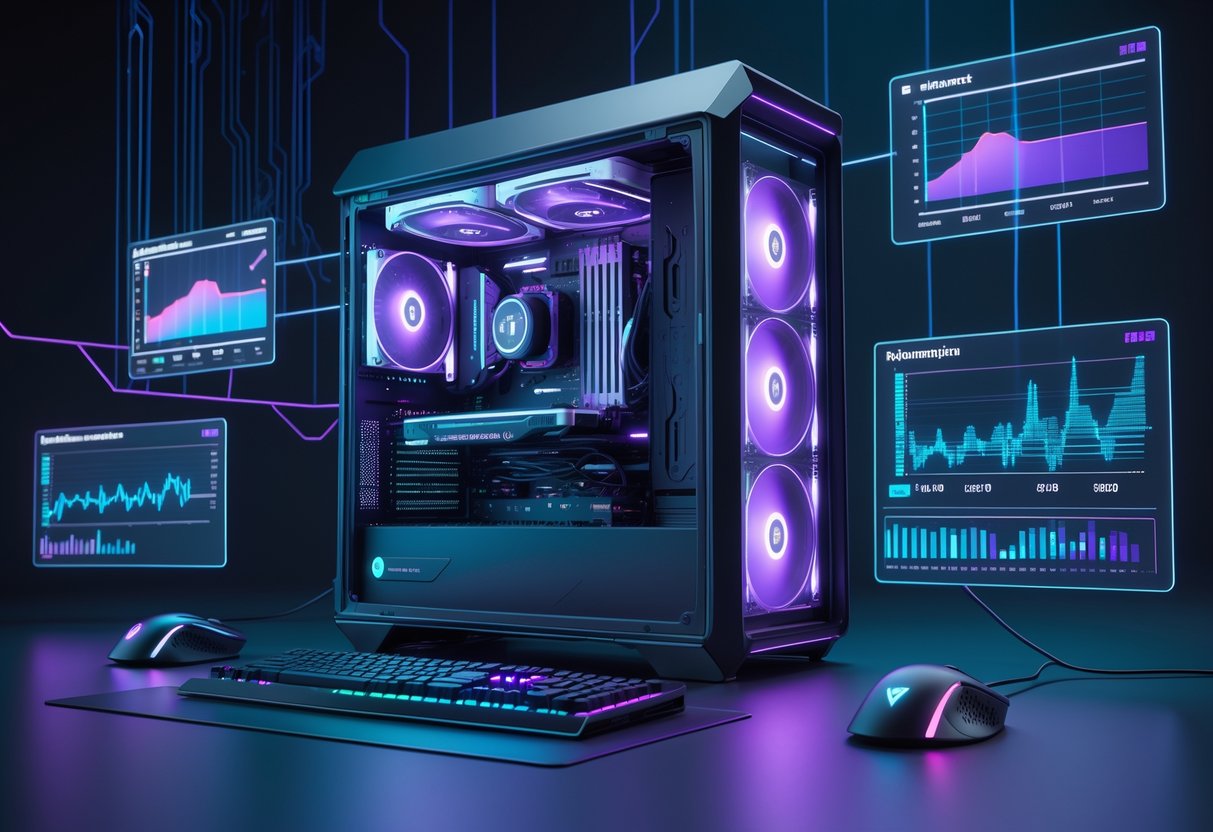
Tweaking your games and graphics drivers can cut input lag by 10-20ms in some cases. The biggest improvements come from turning off v-sync, lowering graphics settings, and using your GPU’s low latency features.
Disabling V-Sync for Lower Input Delay
V-sync matches your game’s frame rate to your monitor’s refresh rate. It stops screen tearing, but it adds a noticeable chunk of input lag.
With v-sync on, your graphics card waits for the monitor to finish each frame before sending the next. This creates a lag between your input and what you see.
V-sync can add anywhere from 16 to 50ms of lag depending on your setup. For competitive gaming, that’s a huge deal.
Turn off v-sync in your graphics settings. Look for options like “Vertical Sync,” “V-sync,” or just “Sync.”
You might see some screen tearing without v-sync—horizontal lines where the image updates. Most competitive players live with it to dodge the lag.
If tearing drives you nuts, try capping your frame rate with something like RTSS (RivaTuner Statistics Server). It adds less than 1ms of lag.
Tuning In-Game Graphics Settings
Higher frame rates mean lower input lag. Dropping a few graphics settings can make a big difference.
Start with these:
- Shadow Quality: Low or Medium
- Anti-aliasing: Off or FXAA
- Ambient Occlusion: Off
- Reflections: Low
- Texture Quality: Medium (unless you’ve got loads of VRAM)
Resolution matters a lot. Going from 1440p to 1080p can double your frame rate in tough games.
Turn off triple buffering if you see it. It adds input lag, just like v-sync.
Use fullscreen mode instead of borderless windowed. Windowed modes can tack on 3-10ms of lag in some games.
Some games even have input lag settings. Look for “Reduce Input Lag” or “Low Latency Mode” in the graphics menu.
Leveraging Low Latency Modes by GPU Vendors
NVIDIA and AMD both offer driver features to cut input lag by managing how your CPU and GPU sync up.
NVIDIA’s Ultra-Low Latency Mode limits how many frames your CPU queues up. This shrinks the waiting line.
Find it in NVIDIA Control Panel > Manage 3D Settings > Low Latency Mode. Set it to “Ultra” for competitive games.
AMD’s Radeon Anti-Lag does a similar job—syncing CPU and GPU so the CPU doesn’t get too far ahead.
Enable it in AMD Radeon Software under the game’s profile.
Both modes work best when your graphics card isn’t maxed out. Sometimes you’ll lose 5-10% performance to shave off input lag.
Test these settings with each game. Some games benefit more than others.
Operating System and Driver Updates
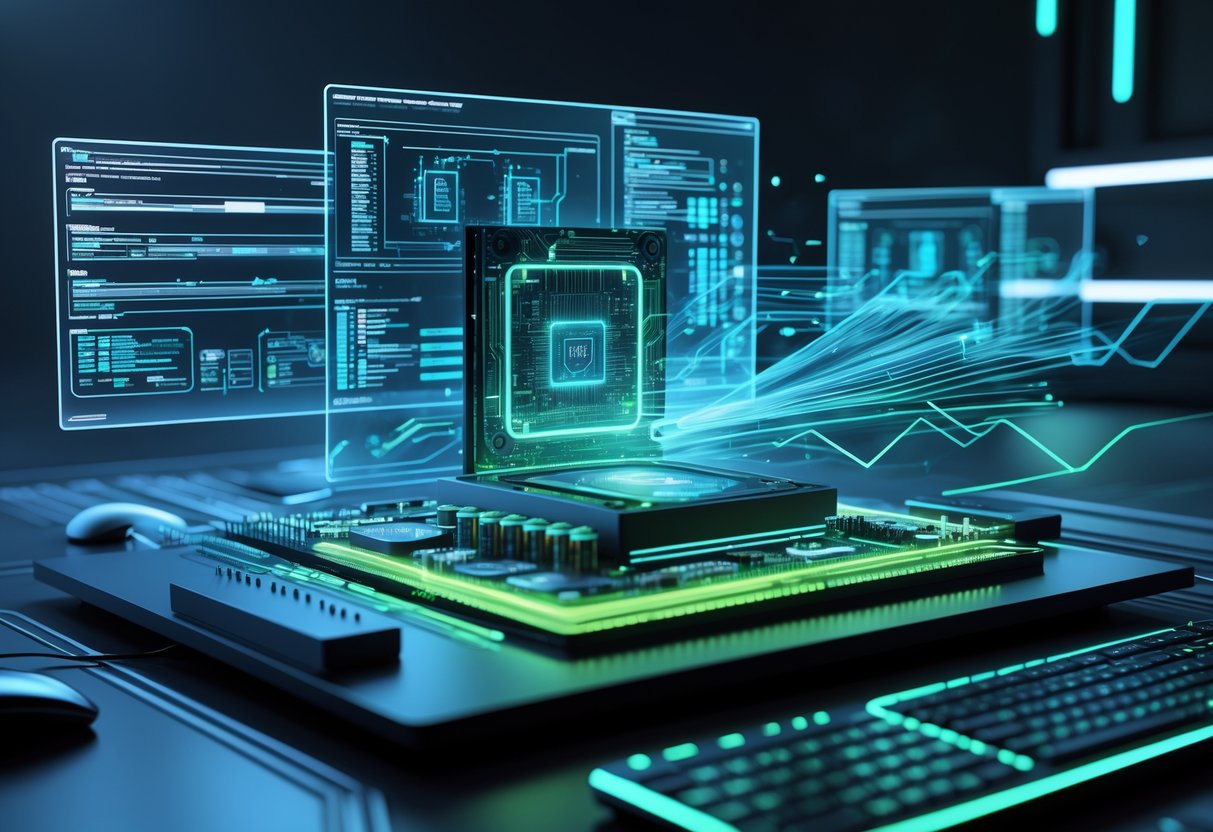
Old operating systems and drivers often cause input lag on gaming PCs. Windows updates can include performance boosts that directly cut input latency, and graphics or chipset driver updates keep your system running smoother for games.
Keeping Windows and MacOS Up-to-Date
I’ve seen so many gamers run into input lag just because they turned off automatic updates. Honestly, that’s a tough lesson for anyone who cares about competitive gaming.
Windows Updates: Windows updates carry important performance fixes that can really affect input latency. Microsoft pushes out improvements to the kernel timer resolution and USB polling rates pretty often.
Hit Windows Key + I, then head to “Update & Security.” Click “Check for updates” and grab everything that’s available.
Critical update types for gamers:
- Driver updates – Fix hardware compatibility
- Security patches – Cut down on background scanning delays
- Performance updates – Boost system responsiveness
MacOS Updates: Mac users should turn on automatic updates in System Preferences. Apple’s Metal graphics API updates actually help input responsiveness in games that support it.
Gaming expert James Connolly said, “We consistently see 5-10ms input lag reductions after major Windows updates. Never skip these if you’re competing seriously.”
Updating Graphics and Chipset Drivers
Graphics drivers really matter most when it comes to reducing input lag. Manufacturers push out game-specific optimisations that can make a big difference.
Graphics Driver Updates: NVIDIA and AMD usually release new drivers every month. These updates bring Low Latency Mode improvements and new optimisations for popular games.
Update methods:
- NVIDIA GeForce Experience – Sends automatic notifications
- AMD Radeon Software – Has a built-in update checker
- Manual downloads – Manufacturer sites have the latest versions
Chipset Driver Updates: Chipset drivers affect USB polling rates and system timing. Outdated chipset drivers can cause mouse and keyboard lag.
Go to your motherboard maker’s website (ASUS, MSI, Gigabyte) and grab the latest chipset package. Install everything—USB controllers, audio drivers, and system management tools.
Warning: Always restart after updating drivers. New drivers only work fully after a reboot, and sometimes input lag improvements don’t show up until then.
Keyboard and Mouse Lag Solutions
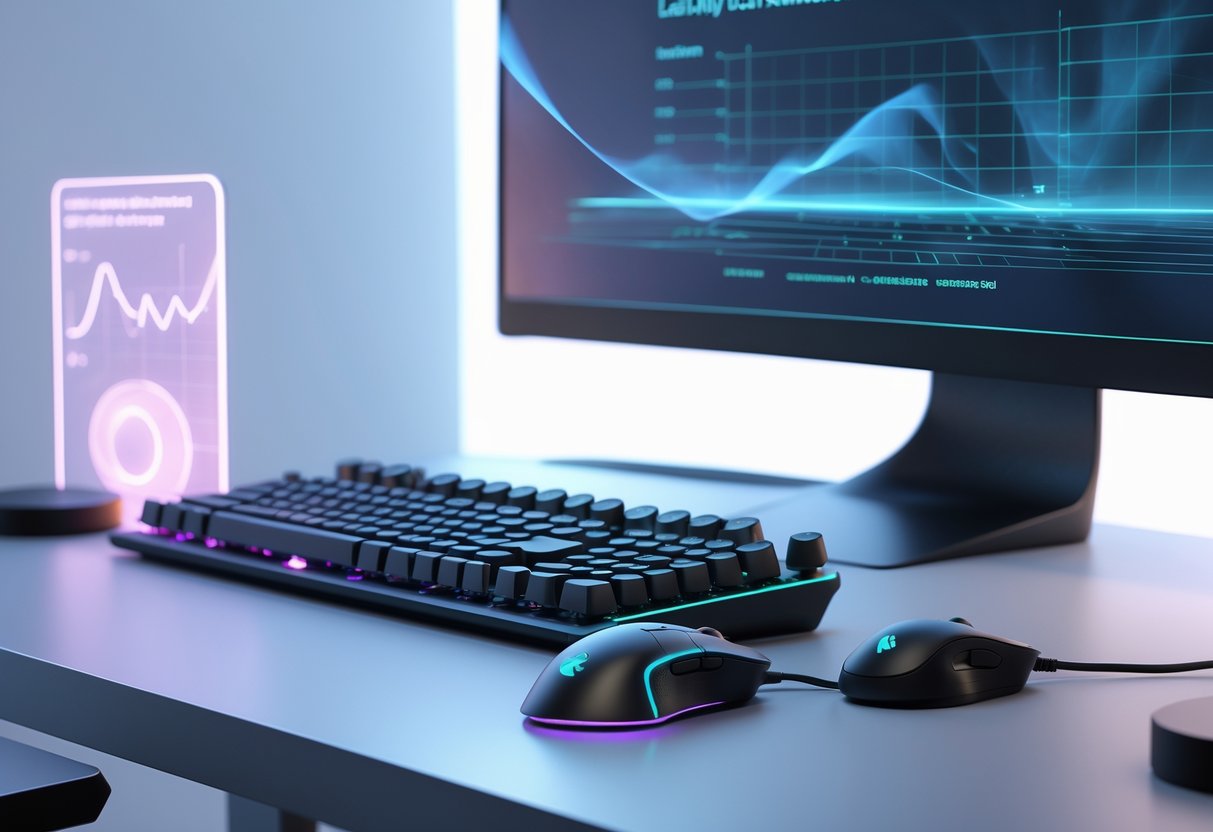
Loose connections and bad settings cause most keyboard and mouse lag. Simple fixes—like checking cables, tweaking repeat rates, or turning off accessibility features—can shave off a few milliseconds of input delay.
Checking Connections and Batteries
Hardware issues usually create the worst input lag. It’s best to check physical connections before diving into software fixes.
For wired keyboards and mice, unplug the USB cable and plug it back in tightly. Try different USB ports, preferably USB 3.0 since they’re faster. Damaged cables look frayed or have bent connectors.
Wireless device checklist:
- Swap out batteries if your devices feel sluggish
- Move the USB receiver as close as you can to your keyboard and mouse
- Remove obstacles between the receiver and devices
- Watch out for interference from phones or other wireless stuff
Some gaming mice have polling rate switches underneath. Set these to 1000Hz for the quickest response. If your wireless mouse supports a wired mode, use that for serious gaming to ditch wireless lag.
Quick win: Test your devices on another computer. If lag vanishes, your system settings are probably the culprit.
Configuring Repeat Rate and Delay
Windows keyboard settings control how quickly your system reacts to keypresses. Wrong settings just add lag to every keystroke.
Open Control Panel > Keyboard to adjust repeat settings. Slide Repeat delay to “Short” and set Repeat rate to “Fast”. These tweaks make sure your keys respond almost instantly.
Optimal settings for gaming:
| Setting | Gaming Value | Typing Value |
|---|---|---|
| Repeat delay | Shortest | Short |
| Repeat rate | Fastest | Fast |
| Cursor blink rate | None | Medium |
Some gaming keyboards come with their own software, ignoring Windows settings entirely. Check your brand’s control panel for “Game Mode” or “Performance Mode” if you want even less lag.
Mouse settings matter too. In Control Panel > Mouse, turn off “Enhance pointer precision”—it just adds extra processing. Set pointer speed to the 6th notch from the left for true 1:1 movement.
Disabling Unnecessary Accessibility Features
Windows accessibility features help some folks, but for most gamers, they just add input lag. These features process every keystroke before sending it to your programs.
Filter Keys blocks repeated keypresses but adds delay. Go to Settings > Ease of Access > Keyboard and turn off Filter Keys. This one change can cut 50-100ms of lag.
Sticky Keys lets you press modifier keys one at a time, but unless you need it, turn it off in the same menu.
Other features to disable:
- Toggle Keys (makes beeps for Caps Lock)
- Mouse Keys (lets the number pad move your mouse)
- High contrast mode (changes how Windows draws graphics)
Warning: Some programs might turn these features back on after big Windows updates. Double-check your settings if you notice lag returning.
For gaming mice, make sure to turn off “Enhance pointer precision” and any mouse acceleration. These try to predict your movement, but in fast-paced games, they just slow things down.
Test your changes by typing quickly in Notepad or moving your mouse in circles. You should feel instant feedback with no lag or missed inputs.
Special Considerations for Consoles and TVs
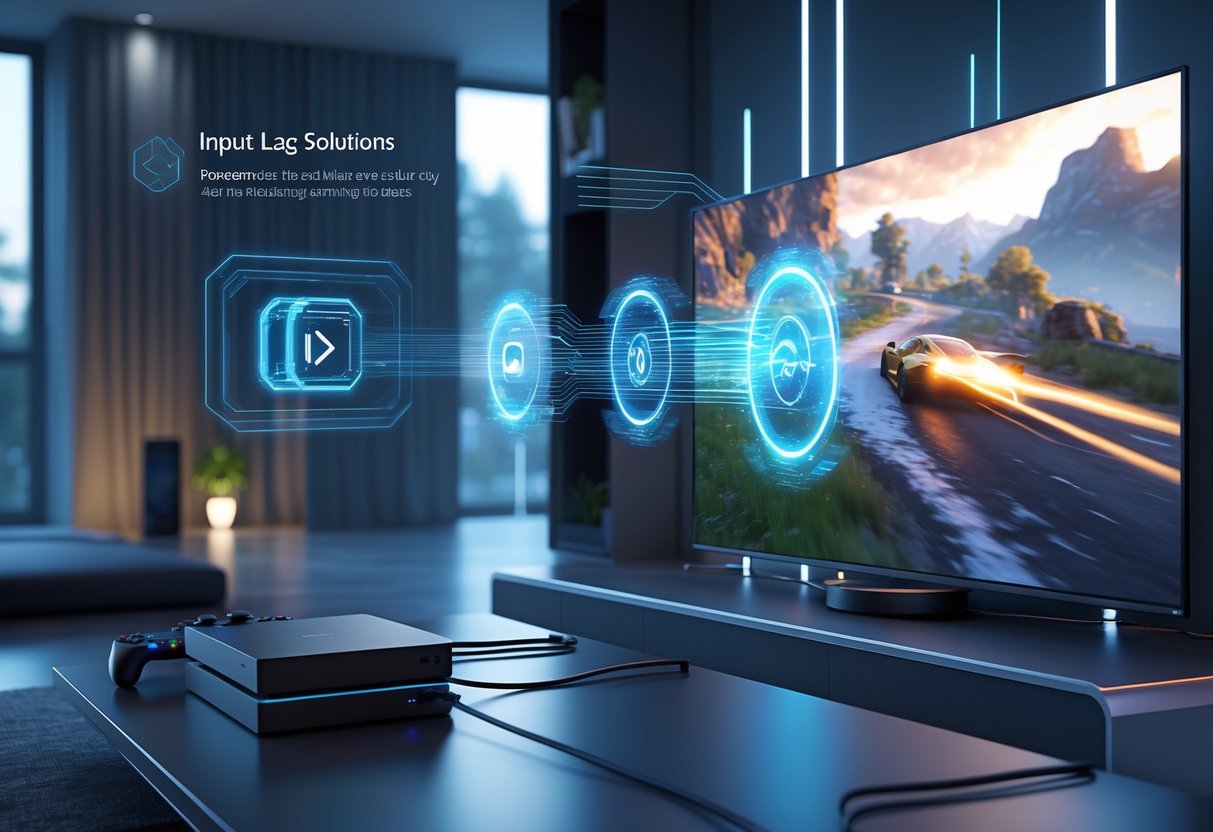
Gaming consoles need a different approach for input lag than PCs. Most TVs are set up for movies, not games, which adds extra delay.
Enabling Game Modes on TVs
Most newer TVs have a Game Mode setting that slashes input lag. Game Mode turns off image processing features like motion smoothing and upscaling that slow things down.
Game Mode usually cuts input lag by 20-50 milliseconds. You can find it in your TV’s picture or HDMI settings.
To enable Game Mode:
- Open your TV’s settings
- Look for “Picture Mode” or “HDMI Settings”
- Pick “Game Mode” or “Gaming” preset
- Turn it on for the HDMI port your console uses
Some TVs will auto-detect your console and switch to Game Mode, but I recommend checking manually to be sure.
Other display tweaks:
- Turn off motion interpolation (that weird soap opera effect)
- Disable noise reduction
- Set sharpness as low as possible
Try different HDMI ports—some are actually built for gaming and have less lag.
Reducing Latency on Xbox and PlayStation
Xbox and PlayStation consoles both have settings to help cut input lag, besides what you do on your TV.
Xbox Series X/S settings:
- Turn on “Auto Low Latency Mode” in display settings
- Disable “Variable Refresh Rate” if you run into issues
- Use “Instant-on” power mode for quicker startups
- Enable “Performance Mode” in games that support it
- Turn off “HDCP” when you’re not streaming
- Use wired controllers instead of wireless if you can
Both consoles work better with good HDMI cables. Damaged cables can cause lag and all sorts of weird signal problems.
Controller tips:
- Keep wireless controllers close to your console
- Plug in your controller for wired mode during competitive matches
- Swap out controller batteries often—low power makes lag worse
Older consoles sometimes get detected as 480i on new TVs, which leads to lag from deinterlacing. Set your console to progressive scan if you can.
Monitoring and Maintaining Optimal Performance

You need to check your input lag regularly to keep it as low as possible. Most gamers set things up once and forget about it, but drivers change, settings shift, and hardware wears out.
Regularly Testing Input Delay
Measure input lag every month or so to catch problems before they wreck your gameplay.
The quickest way is with built-in monitor tests. Many gaming monitors now have input lag testing tools in their menus. These give you a basic reading in milliseconds.
For better accuracy, try: • Online input lag tests – TestUFO and similar sites let you check in your browser • NVIDIA Reflex Analyser – Built into GeForce Experience for some games • High-speed camera method – Record your mouse clicks and screen at 240fps or above
Warning: Different games have different input lag. Test the ones you play most.
Jot down your results—date, game, and lag times. It helps you spot trends and catch problems early.
Proactive Maintenance Tips
Stay on top of maintenance to keep your system snappy and prevent input lag from creeping back.
Update graphics drivers monthly. NVIDIA and AMD push out new drivers that cut input lag for certain games. Turn on automatic updates or check manually.
Clean your system every three months. Dust causes overheating, which slows things down. Clean out fans, vents, and components at least quarterly.
Check background processes weekly. Open Task Manager and see what’s hogging CPU or RAM. Shut down anything you don’t need before gaming.
Reset your monitor settings once a year. Do a factory reset, then reapply your tweaks. This clears out any corrupted settings.
Keep USB ports clean and check cable connections often. Loose cables can cause random input lag that’s hard to track down.
Frequently Asked Questions
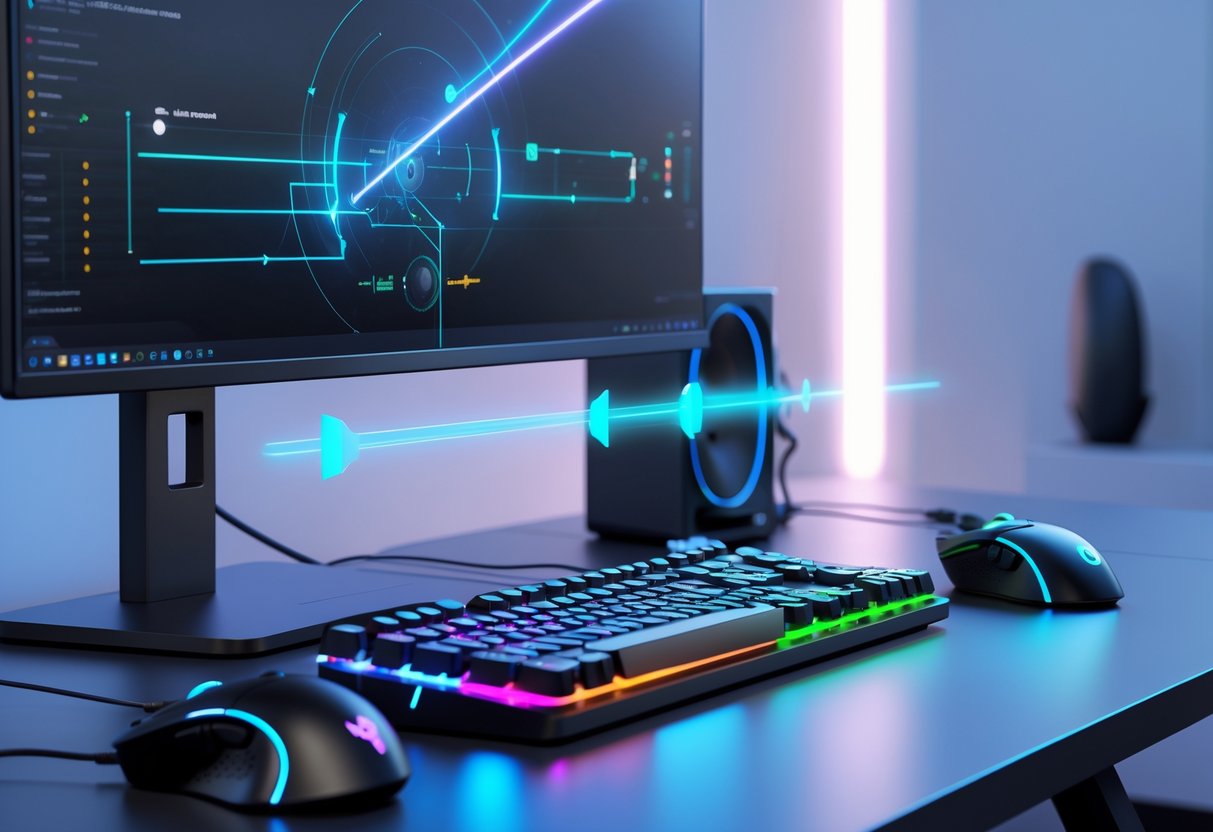
Here are some common questions about fixing input delay for different gaming setups. We’ll cover PC optimisation, console tweaks, and hardware troubleshooting.
What are some effective methods for reducing input delay on a personal computer?
First, turn off V-Sync in your game settings. V-Sync syncs frames but adds a lot of delay between your actions and what you see.
Keep your graphics drivers up to date. NVIDIA and AMD both release drivers that can reduce input delay by a few milliseconds.
Turn on Game Mode in Windows 11. This gives games priority and shuts down background tasks that slow you down.
If your graphics card supports it, use NVIDIA Reflex or AMD Anti-Lag. These can cut input delay by up to 50% in some games.
Set your monitor to its highest refresh rate. A 144Hz display feels way more responsive than 60Hz, even if your FPS doesn’t always match.
Can you offer tips on how to alleviate input lag issues when using a television for gaming?
Switch your TV to Game Mode right away. Game Mode turns off image processing that adds 20-50ms of lag.
Use HDMI 2.1 cables and ports if you have them. They support higher refresh rates and Variable Refresh Rate.
Turn off motion smoothing and any “enhancement” features. These just add extra frames of delay.
Sit closer to your TV if you can. Bigger screens sometimes make input lag feel worse because your eyes travel farther.
If you’re really serious about gaming, consider a monitor instead. Even cheap gaming monitors usually have 5-15ms input lag, while TVs can be 30-50ms.
What steps can one take to minimise input delay while playing on consoles like the PS5?
Turn on 120Hz output in your PS5 display settings. Even if the game runs at 60 FPS, it can still help reduce lag.
Pick Performance Mode in games instead of Quality Mode. Higher frame rates mean less time between your input and what’s on screen.
Plug in your controller with a USB cable. Wired beats wireless by a few milliseconds.
Turn off HDR if your display isn’t high-end. Bad HDR setups can add delay on some TVs and monitors.
Close background apps and stop downloads while you play.
How does one go about fixing input delay issues with a PC gaming controller?
If you can, use a wired connection. USB cables cut out radio delays and battery issues.
Update your controller drivers through Device Manager or the manufacturer’s app. Old drivers can slow things down.
Keep your controller close to the receiver if you’re wireless. Move phones and routers away from your gaming space.
If your controller lets you, try lowering the polling rate. Some third-party controllers feel better at 500Hz than 1000Hz.
Shut down extra controller programs running at the same time. Too many apps can cause conflicts and lag.
Are there any recommended settings or tools to help decrease input delay in games like Fortnite on PC?
Set Fortnite to Fullscreen mode. This gives it exclusive control over your graphics card.
Turn on NVIDIA Reflex Low Latency in Fortnite’s settings if you have a supported card. It can cut input delay by 20-30ms.
Cap your frame rate just below your monitor’s refresh rate. For a 144Hz monitor, try 120-140 FPS for smoothness.
Use DirectX 12 in Fortnite’s advanced settings. DirectX 12 usually has lower input delay than DirectX 11.
Lower your graphics settings to keep your FPS high. Input delay drops a lot when you stay above 100 FPS.
What could be causing input lag with my keyboard and how can I rectify it?
If you’re using a wireless or membrane keyboard, try switching to a wired mechanical one. Mechanical switches react quicker, and a wired connection just skips all that radio delay nonsense.
Test out different USB ports on your computer. Sometimes, those USB 3.0 ports just don’t play nice with older keyboards.
Head into your Windows accessibility settings and turn off Filter Keys and Sticky Keys. Honestly, these features can slow things down because they’re trying to help—but sometimes, they just get in the way.
Update your keyboard drivers, or even give the basic Windows drivers a shot. Some of that fancy manufacturer software? It can actually make things lag a bit.
If your keyboard feels inconsistent, give those switches a cleaning. Dust and crumbs love to hide in there and can mess with how quickly your keys respond.

